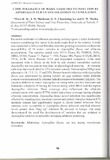Tolerance of maize varieties to infection by aspergillus flavus and aflatoxin accumulation

View/
Date
2011-09Author
Mutitu, E. W.
Chemining'wa, G. N.
Muthomi, J. W.
Weru, R. W.
Language
enMetadata
Show full item recordAbstract
Recurrent outbreaks of aflatoxin poisoning in Kenya pose a major food safety
concern considering that maize is the main staple food in the country. A study
was conducted in Mwea and Waruhiu over two growing seasons to evaluate the
susceptibility of 16 maize varieties to Aspergillus jlavus and aflatoxin
accumulation. The varieties tested were H513, Duma 43, DK8031, DH01,
DH02, DH04, Panner 77, Panner 7-19M, Panner 4M, Panner 67/5243, H515,
H516, KCB, H614, Pioneer 3253 and Katumani composite. Cobs were
inoculated with A. jlavus in the field by silk channel inoculation method.
Aspergillus rot assessment was done at physiological maturity. At maturity
cobs were harvested, dried to 13% moisture content. Sub-samples (500 g) were
adjusted to 10, 13.5, 15, 17 and 20%. Percent kernels infection with Aspergillus
jlavus was determined by plating kernels on agar medium while aflatoxin
content was determined by enzyme linked immunosorbent assay (ELISA). The
varieties differed in visual Aspergillus rot rating with varieties Katumani and
Katumani composite B having the lowest rating while H614 had the highest
Aspergillus infection. Husk coverage also influenced the aflatoxin
contamination with variety P77M, which had a loose coverage having a higher
aflatoxin concentration. Aspergillus jlavus kernel infection was significantly
affected by sampling time, moisture content and variety. Samples stored at 17%
moisture content had significantly higher A. jlavus kernel infection. Most
varieties were susceptible to Aspergillus jlavus infection and had aflatoxin
levels greater than luug kg"I aflatoxin BI allowed in Kenya. The study
demonstrated the need for development of varieties that are resistant to
Aspergillus ear rot as an option for managing aflatoxin poisoning.
Citation
Optimimization of Agricultural Value Chains for sustainable DevelopmentSponsorhip
National Council of Science and Technology, The Kenya Seed CompanyPublisher
Faculty of Agriculture, University of Nairobi
Description
aGRO 2011 biennial conference presentation
